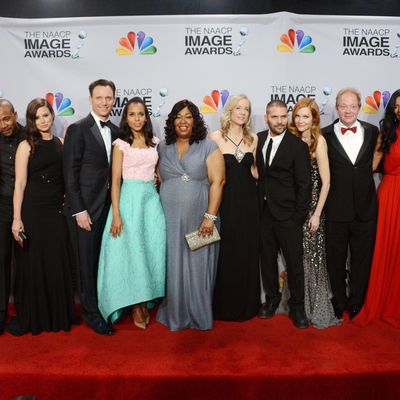
If you’ve been seeing a wealth of conversations recently surrounding the need for greater gender diversity in Hollywood, that’s not entirely by accident. When an article in Vanity Fair arrived online yesterday espousing a new era of late night that was “better than ever,” it didn’t take long before scores of readers pointed out that the accompanying image was, well, 100 percent male. The social-media swarm’s greatest skill, after all, is taking people in power to task. A new report, while quantifying the lack of progress in gender diversity, highlights one method to seeing more women in writers’ rooms, in production companies, and onscreen: Get more women into the business.
The Center for the Study of Women in Television & Film releases a report every year that looks at data from 14 television networks to compare how often and under what circumstances women tend to be hired in the industry. The so-called Boxed In report has revealed that in the past year, while there have been some slight advances, one might be forgiven for seeing our current time as a frustratingly stagnant era for women in TV. As Martha Lauzen, the executive director of the CSWTF, put it: “We are no longer experiencing the incremental growth we saw in the late 1990s and 2000s.”
But when there are women in leadership, changes do occur. The report shows that female executive producers hire other women to write, direct, act, and edit. “For example, on broadcast programs with at least one female creator, women comprised 50% of writers,” the report details. On the flip side, “on programs with no female creators, women comprised 15% of writers.” This revelation, Melissa Silverstein, the artistic director of the Athena Film Festival, tells us that the biggest way to move forward in the face of “robust conversation but flatlining success” is for both male and female higher-ups to simply “hire women.”
Silverstein told the Cut on the phone, “In the film business, people say ‘women can’t do this or this’ or ‘women don’t want to make movies like x, y, or z’ and the television industry throws that out the door when you look at the types of TV shows that women are creating.” But it isn’t just executive positions that need more women, Silverstein says. “[It] goes with the DGA study released [this year] about women directors at the entry level — when you’ve never directed an episode before — something like 82 percent of those are male.” She continued, “Numbers have increased … they were so incredibly low that they had to increase, but how are you supposed to rise up in the ranks if you can’t even get the first job?” Relying on female executive producers and showrunners — who only comprise 23 percent of all executive producers on the 14 networks studied in the report — to hire other women is simply not enough.
When asked about Monday’s Vanity Fair misstep, Silverstein was blunt: “When people are feeling that things are moving in the right direction, you get slapped in the face with reality,” she told the Cut. “Hollywood actresses are talking about it, People magazine is covering it, Sandra Bullock is talking about the gender crisis.” But that discussion, no matter how vigorous, doesn’t change the facts. The 2014–2015 study showed that female writers in TV declined one percent from 25 percent in the last year, and the 12 percent of female directors in TV went down to 11 percent in the same time frame. “It only goes so far before it becomes blatant sexism,” Silverstein adds. “They don’t get a pass for that, at all.”
As for women in front of the camera, while the numbers are better than they are for directors and producers, they are still slightly unbalanced with 42 percent of all speaking characters and 42 percent of major characters. The CSWTF report focuses primarily on women in its research, but one dispiriting diversity stat is put forward: On camera, “77% of female characters were white, 15% were African-American, 3% were Latina, 4% were Asian, and 1% were of some other race or ethnicity.”
Wherever the numbers are, Silverstein emphasized again and again that the most essential thing to do is also the most simple. Despite last year’s stalled progress, she affirmed that now more than ever is the time to “hire women.”

